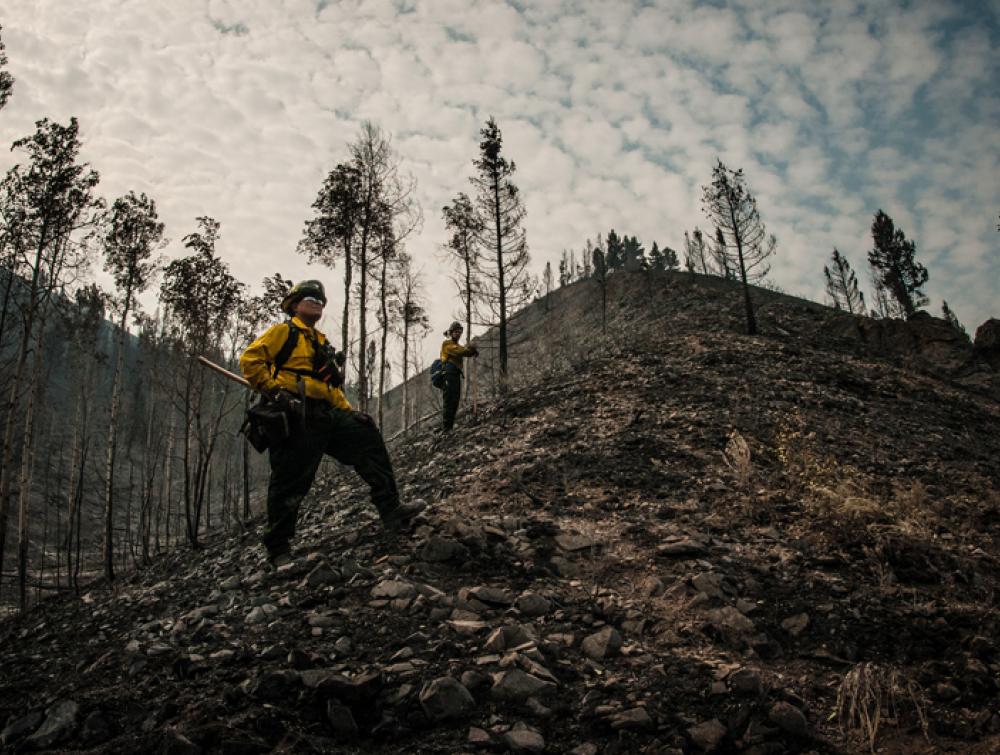Concerns about the Daines-Feinstein wildfire bill

A firefighter on U.S. Forest Service land in Idaho.
Lance Cheung (USDA), flickr
Components of the bill could fast-track large logging projects in backcountry areas by legislating exemptions to bypass normal environmental, judicial, and public review
WASHINGTON, August 6, 2020 ----- The Wilderness Society strongly opposes portions of the “Emergency Wildfire and Public Safety Act of 2020,” which was introduced by Senators Daines and Feinstein on August 4, 2020.
This legislation would undermine bedrock environmental laws and the rule of law in order to promote increased logging of national forests far from the homes and communities that are in most need of attention to reduce wildfire risk.
Properly addressing wildfire risk requires effective planning, science-based strategies and serious funding from Congress. Communities need to reduce available fuel for wildfires and build more fire-resistant homes if they are near burn-prone areas.
Key components of the Daines-Feinstein bill miss the mark and include concerning provisions that could fast-track large logging projects in backcountry areas by legislating exemptions to bypass normal environmental, judicial, and public review. These provisions stand in stark contrast to the sensible, science-based approaches included in this bill that would help communities in fire-prone areas.
Background on Daines-Feinstein wildfire bill
The science is clear that an effective way to protect people and property from wildfire dangers is to reduce flammable materials in close proximity to homes and communities. However, this misguided legislation would have federal land managers do just the opposite by, among things, directing them to go through an elaborate process to select three large “forest landscape projects” in western national forests where logging would be exempt from normal judicial review. (Sec. 101)
Furthermore, the legislation would exempt the U.S. Forest Service from normal environmental review and public involvement requirements to create very large “fuel breaks” up to 1,000 feet wide and 3,000 acres in size. These linear logging zones could be located adjacent to recreational trails and in remote roadless areas. (Sec. 103)
The legislation also would give supposedly “emergency” legal authority for the Forest Service to bypass normal opportunities for the public to raise concerns about controversial salvage logging operations up to 10,000 acres in size. This “emergency” authority could be applied to salvage logging projects that do nothing to reduce fire risks to homes or communities, while potentially causing serious harm to water quality and wildlife habitat. (Sec. 104)
In addition, the legislation would reduce protection for threatened and endangered species by excusing federal land managers from reinitiating consultation with the U.S. Fish and Wildlife Service in some circumstances when “new information” comes to light about potential impacts of plans or projects on those imperiled species. This exemption would go significantly beyond an agreement negotiated by Congress just two years ago to address concerns about a federal court ruling in the “Cottonwood” case. (Sec. 105)
In sum, these sections of the Daines-Feinstein wildfire bill could do serious damage to our national forests, environmental laws, public participation, and the judicial review process. It also would divert federal land managers’ attention and resources away from fuel reduction activities near homes and communities.
The Wilderness Society urges members of Congress not to advance this legislation and instead to pursue better wildfire defense strategies.
A Better Approach
The Wilderness Society believes it is imperative to prioritize effective wildfire defense strategies in the right places using the best available science and planning tools. Climate change is producing more intense fire seasons with tragic fires and enormous costs. Protection of life and property should be the top priority for wildfire defense.
One effective way to protect people and property from wildfires is to reduce the available fire “fuel” near homes and communities. Building homes in or near previously wild areas (the wildland-urban interface) means that wildfires will present a greater danger to lives, property and the residential environment. Building more fire-resistant homes, removing vegetation around buildings and having community preparedness and evacuation plans can all help reduce fire risk.
When it comes to forest management, the most impactful management relies on removing smaller diameter fuels and doing prescribed burns near communities, NOT the removal of large, more fire-resistant trees commonly sought by the timber industry.
While federal funding to address wildfire has improved in recent years, the Trump administration has proposed reductions in many important Forest Service programs.
The timber industry argues that thinning the nation’s forests will solve the wildfire problem. This approach is a feature of the Daines-Feinstein bill. However, logging deep in backcountry forests far from communities does not address the risk to residential areas. Logging in remote places can degrade water quality, recreation experiences and wildlife habitat and does not make people safer.
In post-fire restoration, “salvage logging,” is a particularly damaging practice. Salvage logging refers to the removal of burned trees after a fire. While this may sound harmless, scientists say that burned trees left in the wake of fires serve an important role in western forests, spurring improved biodiversity and supporting life ranging from shrubs to bears. Removing these trees could actually exacerbate fire damage, increase future risks and send ash and sediment into area streams. By encouraging salvage logging, the Daines-Feinstein bill focuses on the wrong places and the wrong strategies.
Contact: Michael Reinemer, michael_reinemer@tws.org, 202-429-3949
